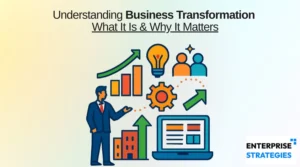Most enterprise transformations falter not because of a lack of ambition, but because teams pick the wrong architect partner. You’ll find out here when you truly need outside help, exactly what to evaluate in your shortlist, a step-by-step vetting framework, proven cost-control tactics, a 5-question diagnostic, an ROI comparison table, a sector spotlight, and a peek at emerging trends. Read on, and you’ll have a concrete playbook—no ivory-tower theory, just what works on the shop floor.
Why the Right Enterprise Architecture Partner Changes Everything
Attempting a large-scale Enterprise Architecture project solo often ends in half-built integrations and frustrated executives.
- Legacy systems refuse to talk to new platforms.
- Data definitions vary wildly between teams.
- Your roadmap slips 3–6 months every quarter.
Bringing in a partner with hands-on delivery muscle can flip those odds: in a McKinsey interview, Jon Garcia notes that roughly 70 percent of transformations stall when companies underestimate complexity and lack ongoing guidance McKinsey & Company. Meanwhile, academic research shared by Raconteur shows only 20 percent of firms hit more than three-quarters of their expected revenue gains—proof that execution, not vision, wins the day.
1. How to Know If You Really Need an Enterprise Architecture Partner
Before you draft that RFP, ask yourself:
- Are IT and business still debating basic data definitions?
- Does your quarterly roadmap slip by months?
- Do you juggle more point solutions than people can track?
If you tick two or more, it’s time to call in reinforcements. Enterprise architecture is a conceptual blueprint that aligns people, data, and technology—critical when your internal teams hit their limit.
2. Key Criteria for Selecting Your Enterprise Architecture Partner
Skip the slide decks. In your vendor calls, look for:
→ Full-Lifecycle Delivery
Have they driven Enterprise Architecture from strategy through governance and into production operations?
→ Deep Domain Expertise
For financial services, you need a partner who knows audit workflows and compliance like the back of their hand.
→ Agile, Incremental Delivery
Can they ship working modules every 4–6 weeks, not just big-bang rollouts?
→ Tool-Agnostic Recommendations
They should propose best-fit tech, not upsell their own suite—exactly as the Forbes digital transformation guide recommends.
→ Cultural Fit & Collaboration
Gartner peers highlight that blending a central Enterprise Architecture council with embedded BU architects ensures governance without slowing delivery.
😊 When you start hearing real war stories (not buzzwords) and see low vendor turnover, you’ve found a keeper.
3. A Practical 5-Step Vetting Framework
Treat this like a mini-RFP that ends in code, not slides:
- Define Scope & Outcomes
- Map in-scope systems, processes, data flows.
- Call out out-of-scope work for later phases.
- Baseline Readiness
- Score your state on process documentation, data quality, manager buy-in, staff capacity.
- This directs your partner’s day-one focus.
- Short-List Three Partners
- Require two relevant case studies and client references per candidate.
- Speak to the CFO or CIO who lives with their work daily.
- Two-Week Proof-of-Value
- Wick a spike project on SSO or master-data sync, with deliverables of working code + backlog + next-steps plan.
- Lock in Governance & Commercial Model
- Opt for fixed-price sprints or T&M with caps, and establish a weekly steering committee for course corrections.
This “agile RFP” approach cuts surprises and paints a clear path to real delivery.
4. Controlling Costs & Risks
Poor governance and scope creep drive 90 percent failure rates in some studies. BCG research, as cited by Raconteur, finds 70 percent of transformations fall short of their goals unless rigorously governed.
Cost-control tactics:
→ Lock in a 90-day pilot before full rollout.
→ Tie payments to measurable milestones (e.g., “Auth live,” “Data layer synced”).
→ Cap change requests—any scope add over X days needs executive sign-off.
→ Insist on transparent burn-rate reports and weekly burn-down charts.
5. Diagnostic Tool: Five Questions to Answer Today
Plug these into your next leadership meeting—you’ll know exactly where to push:
- What’s our cost per integration failure?
- How many manual hours do we spend reconciling data weekly?
- What’s the annual downtime cost for failed releases?
- How long does module onboarding take now?
- Which audit/compliance issues have bitten us in the last 12 months?
Your numeric answers spotlight the partner capabilities that move the needle.
6. Quick ROI Comparison: Year 1 vs Year 2
| Area | Year 1 Savings est. | Year 2 Savings est. |
| Automated data reconciliation | $200 K | $450 K |
| Reduced downtime (hrs × rate) | $150 K | $300 K |
| Faster module onboarding | $100 K | $250 K |
Teams following this disciplined playbook often see 2× ROI by Year 2
7. Sector Spotlight: Financial Services
In banking, vendor integration trumps flashy dashboards. A case study in Forbes shows that mismatched data models derail compliance workflows—pick a partner with proven reg-tech chops.
8. Emerging Trends in Enterprise Architecture Partnerships
- AI-Driven Modeling: McKinsey’s “Rewired to Outcompete” underscores how AI can predict impacts before you push code, cutting rework cycles in half.
- Business-Led EA: Embedding architects in business units rather than siloed IT boosts adoption and agility, according to CIO.com which notes only 26 percent of Enterprise Architecture practices currently deliver strategic benefits without this model.
- Digital Twins & Simulation: Early adopters are using “digital twins” to simulate changes, avoiding costly rollbacks in live systems.
Next Steps
Want to benchmark your readiness and spot blind spots before you sign on the dotted line? Email contact@enterprisestrategies.com with subject Readiness Assessment. We’ll send our 10-minute diagnostic tool and a concise gap report—no slides, no sales pitch—so you can make the right call with confidence.




